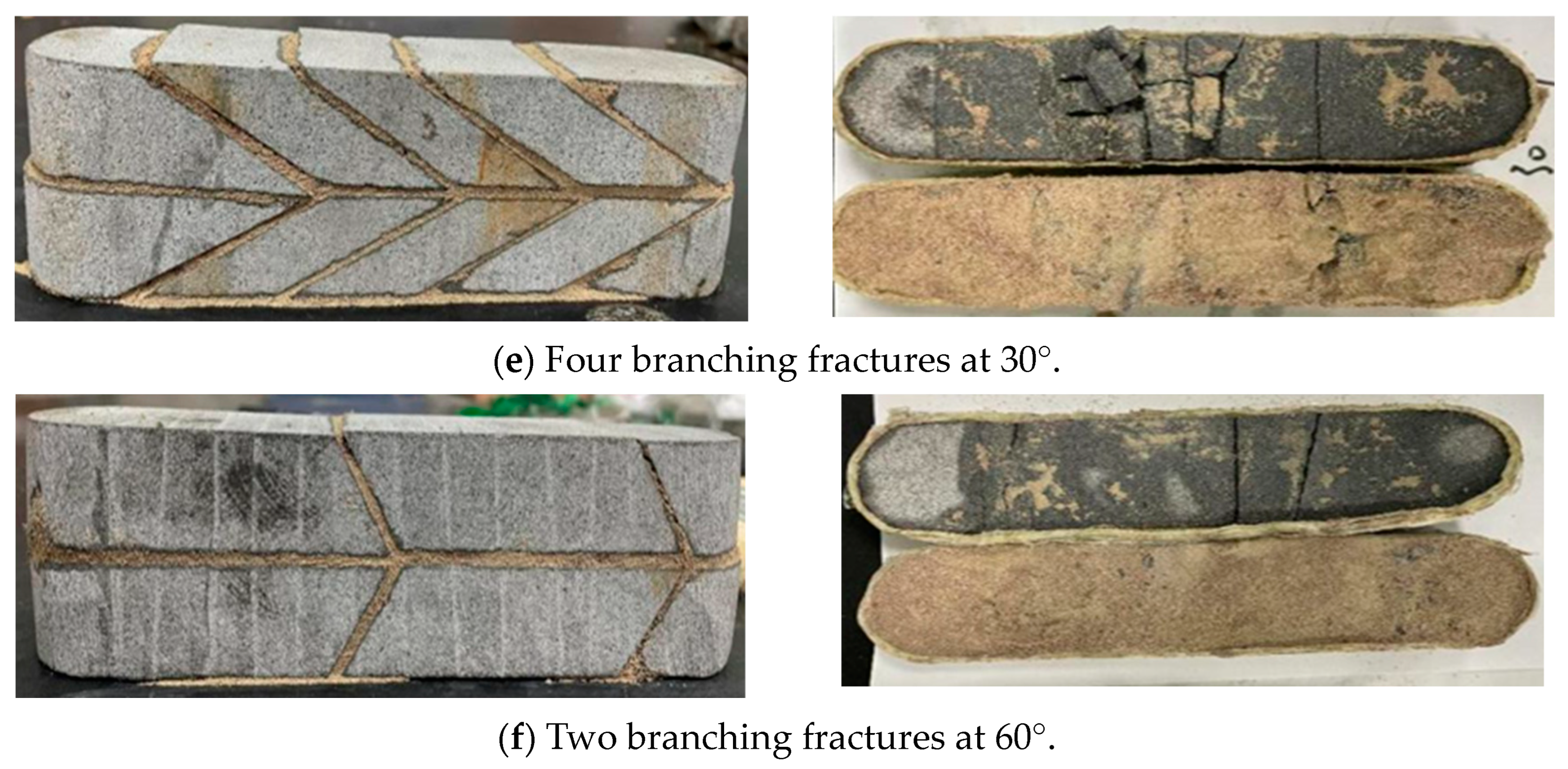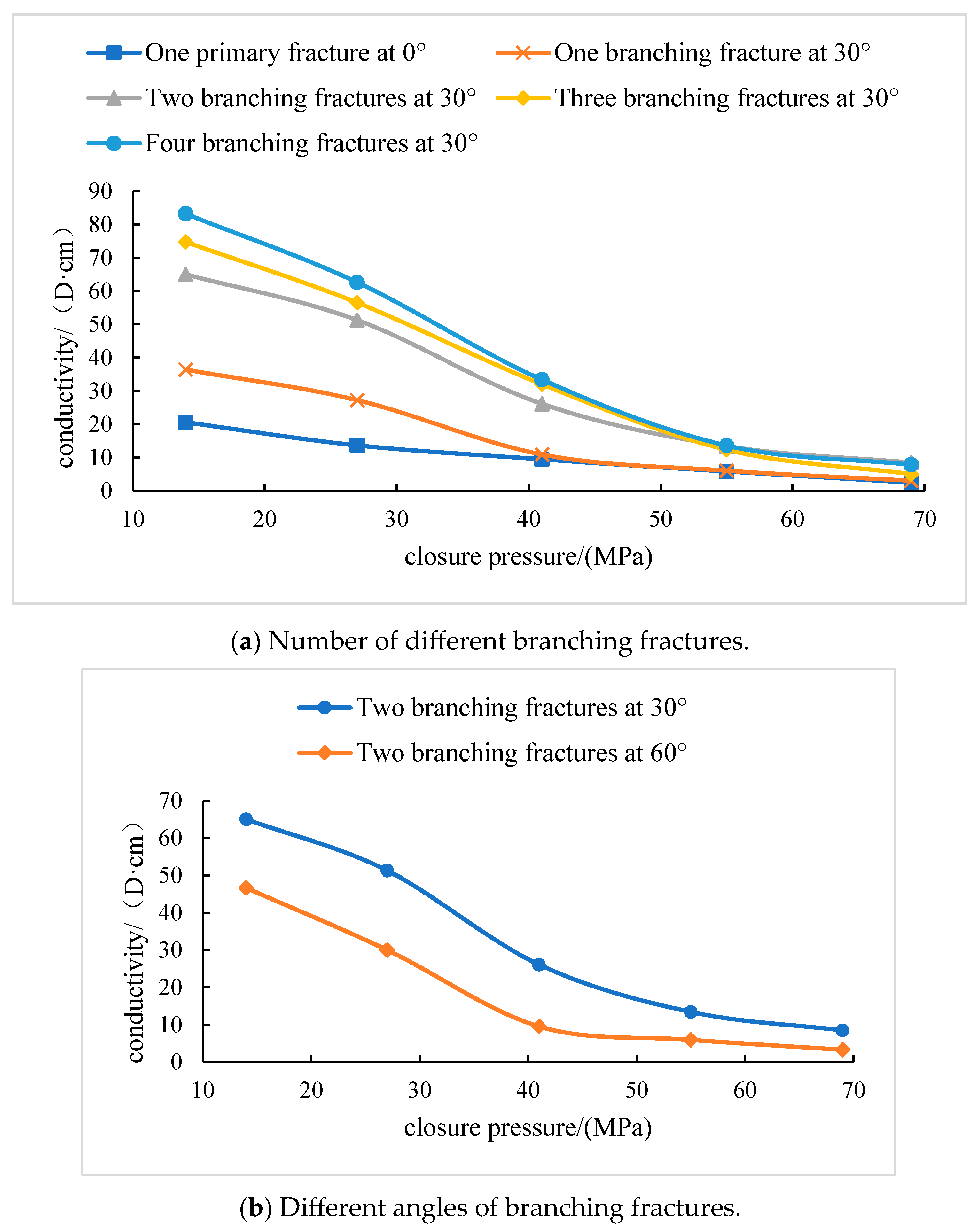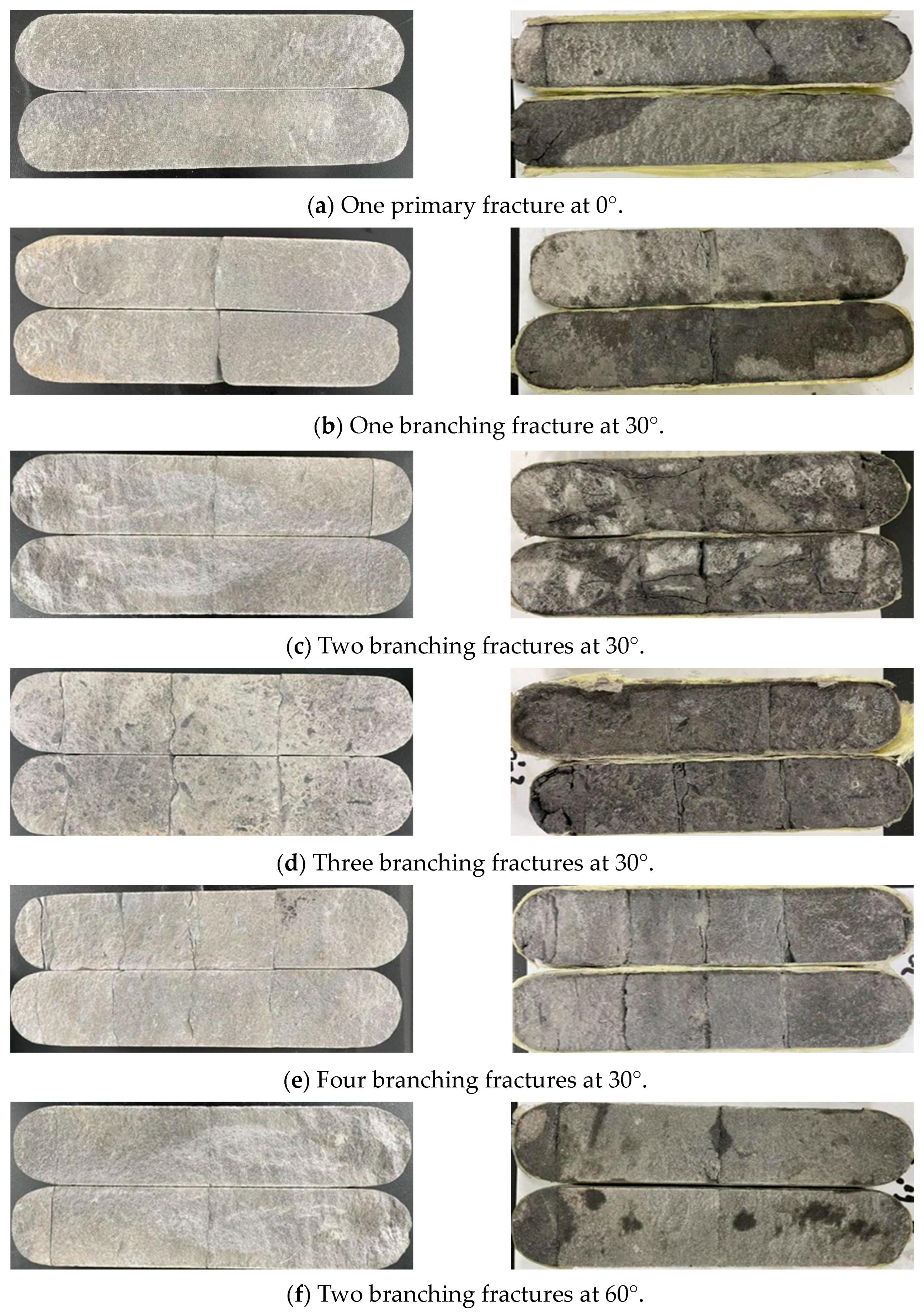Investigation into the Variation Law of Network Fracture Conductivity in Unconventional Oil and Gas Reservoirs
Abstract
1. Introduction
2. Experimental Installation and Experimental Procedures
2.1. Experimental Installation
2.2. Cutting Plan for the Experimental Rock Plate
2.3. Experimental Procedures
3. Analysis of Conductivity Experiments
3.1. Experimental Principle
3.2. The Experiment on Proppant Fracture Conductivity
3.3. Experimental Study on the Conductivity of Self-Propping Fractures
3.4. Comparison and Discussion of Proppant and Self-Propping Fracture Conductivity
4. Conclusions and Recommendations
- (1)
- As closure stress escalates, the conductivity of self-supported fractures significantly diminishes, whereas the conductivity of proppant fractures experiences a more gradual reduction. At low closure pressures, self-supported fractures demonstrate superior conductivity compared to proppant fractures; however, at medium to high closure pressures, proppant fractures exhibit greater conductivity than their self-supported counterparts.
- (2)
- The flow-conducting capacity of cracks with multiple branch seams increases with the number of branch seams, and the branch seams have a significant effect on enhancing the flow-conducting capacity at low and medium closure pressures, while the effect of branch seams on enhancing the flow-conducting capacity is small at high closure pressures.
- (3)
- When the closure pressure and the quantity of branch seams are identical, the inflow capacity is influenced by the angle of the branch seams. Specifically, an increase in the angle of the branch seams correlates with a decrease in the inflow capacity of the fractures. This is attributable to the fact that a larger angle between the secondary seams and the primary seams results in greater resistance to fluid flow, thereby reducing the inflow capacity.
- (4)
- Under the condition of low closure pressure, increasing the number of self-supporting fractures can be considered by increasing the amount of slippery water and optimizing the sand-adding parameters. Under the condition of high closure pressure, attention should be paid to optimizing the proppant placement by means of full-scale sand-spreading, so that all the fractures can develop effective fracture conductivity.
- (5)
- In order to increase the number of branch joints, more complex joints should be adopted in the process of reconstruction. At the same time, the angle between branch joints and main joints can be reduced by means of temporary blocking and turning, so as to improve the overall flow capacity.
Author Contributions
Funding
Data Availability Statement
Conflicts of Interest
References
- Zheng, J.W.; Sun, D.Q.; Li, X.Y.; Zhang, J. Advances in Exploration and Exploitation Technologies of Shale Gas. Nat. Gas Geosci. 2011, 22, 511–517. [Google Scholar]
- Liang, S.; Wan-Yi, Z.; Xiao-Ling, L. The Key Reservoir Fracturing Transformation Technology and Development Trend about the Shale Gas. Geol. Sci. Technol. Inf. 2013, 32, 156–162. [Google Scholar]
- Nie, H.; Zhang, J. Types and characteristics of shale gas reservoir: A case study of Lower Paleozoic in and around Sichuan Basin. Pet. Geol. Exp. 2011, 33, 219–250. [Google Scholar]
- Mingyue, C.U.; Yuzhang, L.I.; Nailing, X.I.; Yunhong, D.I.; Xuemei, Y.A.; Jingjing, D.O.; Haifeng, F.U. Analysis of factors affecting the formation of effective stimulated reservoir volume (ESRV). Oil Drill. Prod. Technol. 2014, 36, 82–87. [Google Scholar]
- Huifen, H.; Junliang, P.; Jian, W. Test method for long-term flow conductivity of propped shale fractures and modifications made on test equipment. Drill. Prod. Technol. 2018, 41, 55–58. [Google Scholar]
- Sun, C. Study on the Decline Characteristics and Influencing Factors of Hydraulic Fractures Conductivity in Shale Reservoirs. Master’s Thesis, Xi’an Shiyou University, Xi’an, China, 2023. [Google Scholar]
- Fredd, C.N.; McConnell, S.B.; Boney, C.L.; England, K.W. Experimental study of fracture conductivity for water-fracturing and conventional fracturing applications. SPE J. 2001, 6, 288–298. [Google Scholar] [CrossRef]
- Zhang, J.; Kamenov, A.; Hill, A.D.; Zhu, D. Laboratory Measurement of Hydraulic-Fracture Conductivities in the Barnett Shale. SPE Prod. Oper. 2014, 29, 216–227. [Google Scholar] [CrossRef]
- Cipolla, C.L.; Lolon, E.P.; Mayerhofer, M.J.; Warpinski, N.R. Fracture Design Considerations in Horizontal Wells Drilled in Unconventional Gas Reservoirs. In Proceedings of the SPE Hydraulic Fracturing Technology Conference, The Woodlands, TX, USA, 19–21 January 2009. [Google Scholar]
- Gao, S. Study on Conductivity of Different Artificial Fracture Types in Shale. Master’s Thesis, University of Petroleum, Beijing, China, 2023. [Google Scholar]
- Liu, J.; Ning, W.; Wang, P. Influence of the Fracture Intersection Angle on Conductivity of Fracture Network: A Case Study of “Bu” Type Structure. Sci. Technol. Eng. 2023, 23, 15465–15472. [Google Scholar]
- Ning, W. Research on Conductivity of Shale “Y”-Shaped cross Fractures. Master’s Thesis, Sichuan University, Chengdu, China, 2021. [Google Scholar]
- Cao, H.T.; Zhan, G.W.; Zhao, Y.; Yu, X.Q. Comparative of conductivity between support fracture and self-support fracture of deep shale reservoir in southern Sichuan basin. Sci. Technol. Eng. 2019, 19, 164–169. [Google Scholar]
- Zhu, H.; Shen, J.; Zhou, H. Numerical simulation on propped fracture conductivity. Acta Pet. Sin. 2018, 39, 1410. [Google Scholar]
- Qingzhi, W.; Shuting, W.; Jinjian, G.; Xiaofei, D.; Feng, W.; Xinjia, L.; Liu, Y. Research on flow conductivity experiment in complex fracture network. Pet. Geol. Recovery Effic. 2016, 23, 116–121. [Google Scholar]
- Zhang, H. Conductivity optimization research of complex network fractures in shale reservoirs of Long maxi Formation in Sichuan Basin. Nat. Gas Geosci. 2019, 30, 955–962. [Google Scholar]
- Yan, G.; Shi, H.; Ma, Y.; Scheuermann, A.; Li, L. Intrinsic permeabilities of transparent soil under various aqueous environmental conditions. Géotechnique Lett. 2022, 12, 225–231. [Google Scholar] [CrossRef]









| Number | Main Fracture and Secondary Fracture Angles/Degrees | Number of Secondary Fractures | Proppant |
|---|---|---|---|
| 1 | 0 | 0 | Mixing 70/140 and 40/70 ceramic beads in a 3:2 ratio, with a main fracture sand concentration of 5 kg/m2 and secondary fracture concentration of 3 kg/m2 |
| 2 | 30 | 1 | |
| 3 | 30 | 2 | |
| 4 | 30 | 3 | |
| 5 | 30 | 4 | |
| 6 | 60 | 2 | |
| 7 | 0 | 0 | Self-supporting fractures do not add proppants |
| 8 | 30 | 1 | |
| 9 | 30 | 2 | |
| 10 | 30 | 3 | |
| 11 | 30 | 4 | |
| 12 | 60 | 2 |
Disclaimer/Publisher’s Note: The statements, opinions and data contained in all publications are solely those of the individual author(s) and contributor(s) and not of MDPI and/or the editor(s). MDPI and/or the editor(s) disclaim responsibility for any injury to people or property resulting from any ideas, methods, instructions or products referred to in the content. |
© 2024 by the authors. Licensee MDPI, Basel, Switzerland. This article is an open access article distributed under the terms and conditions of the Creative Commons Attribution (CC BY) license (https://creativecommons.org/licenses/by/4.0/).
Share and Cite
Ci, J.; Wang, L.; Xiong, F.; Zhao, Y. Investigation into the Variation Law of Network Fracture Conductivity in Unconventional Oil and Gas Reservoirs. Processes 2024, 12, 1803. https://doi.org/10.3390/pr12091803
Ci J, Wang L, Xiong F, Zhao Y. Investigation into the Variation Law of Network Fracture Conductivity in Unconventional Oil and Gas Reservoirs. Processes. 2024; 12(9):1803. https://doi.org/10.3390/pr12091803
Chicago/Turabian StyleCi, Jianfa, Lei Wang, Feiyang Xiong, and Yanxin Zhao. 2024. "Investigation into the Variation Law of Network Fracture Conductivity in Unconventional Oil and Gas Reservoirs" Processes 12, no. 9: 1803. https://doi.org/10.3390/pr12091803
APA StyleCi, J., Wang, L., Xiong, F., & Zhao, Y. (2024). Investigation into the Variation Law of Network Fracture Conductivity in Unconventional Oil and Gas Reservoirs. Processes, 12(9), 1803. https://doi.org/10.3390/pr12091803





